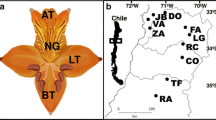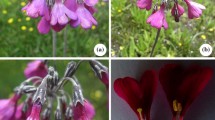Abstract
The selective role of pollinators on the floral phenotype has been identified as the main force behind angiosperm diversification. However, in generalized plant–pollinator interactions this association may not be that evident, since pollinator assemblages vary in composition among populations, possibly influencing the direction and intensity of floral trait selection. In this study we determine whether there was spatial variation in pollinator assemblages and the selective forces they exert in ten populations of Alstroemeria ligtu var. simsii. We characterized the whole pollinator assemblage in ten populations, quantified four floral attraction traits and determined potential selection targets in each of the study populations. Our results revealed that populations differed in the composition of their pollinator assemblages, and the pollinators with the highest visitation rates also differed among populations. Using phenotypic selection analysis we detected significant differentials and selection gradients only in two of the ten populations, for corolla tube length and ratio of the nectar guide. The spatial variation in selection showed that linear selection acting upon these traits differed significantly among the studied populations. Our study indicates that selection can be detected in generalized plant–pollinator systems and brings new evidence of phenotypic selection variation in space for this endemic plant species. Future studies are needed to determine whether the selective patterns described here are consistent over time and whether they produce evolutionary change in the populations under study.


Similar content being viewed by others
References
Aigner PA (2005) Variation in pollination performance gradients in a Dudleya species complex: can generalization promote floral divergence? Funct Ecol 19:681–689
Alexandersson R, Johnson SD (2002) Pollinator-mediated selection of flower-tube length in a hawkmoth-pollinated Gladiolus (Iridaceae). Proc R Soc Lond B 269:631–636
Anderson B, Alexandersson R, Johnson SD (2009) Evolution and coexistence of pollination ecotypes in an African Gladiolus (Iridaceae). Evolution 64–4:960–972
Arroyo KM, Uslar P (1993) Breeding systems in a temperate Mediterranean type climate montane sclerophyllous forest in central Chile. Bot J Linn Soc 111:83–102
Ashman TL, Majestic C (2006) Genetic constraints on floral evolution: a review and evaluation of patterns. Heredity 96:343–352
Ashman TL, Morgan MT (2004) Explaining phenotypic selection on plant attractive characters: male function, gender balance or ecological context? Proc R Soc Lond B 271:553–559
Baeza C, Finot V, Ruiz E, Carrasco P, Novoa P, Stuessy T, González AV (2015) Comparative karyotypic analysis and cytotaxonomy in the Alstroemeria ligtu L. (Alstroemeriaceae) complex of Chile. Braz J Bot. https://doi.org/10.1007/s40415-015-0220-4
Botto-Mahan C, Ojeda-Camacho M (2000) The importance of floral damage for pollinator visitation in Alstroemeria ligtu L. Rev Chil Entomol 26:73–76
Botto-Mahan C, Ramírez P, Ossa C, Medel R, Ojeda-Camacho M, González A (2011) Floral herbivory affects female reproductive success and pollinator visitation in the perennial herb Alstroemeria ligtu (Alstroemeriaceae). Int J Plant Sci 172:1130–1136
Caballero P, Ossa CG, González WL, González-Browne C, Astorga G, Murúa MM, Medel R (2013) Testing non-additive effects of nectar-robbing ants and hummingbird pollination on the reproductive success of a parasitic plant. Plant Ecol 214:633–640
Caruso CM (2000) Competition for pollination influences selection on floral traits of Ipomopsis aggregata. Evolution 54:1546–1557
Caruso CM (2001) Differential selection on floral traits of Ipomopsis aggregate growing in contrasting environments. Oikos 94:295–302
Caruso CM, Peterson B, Ridley C (2003) Natural selection on floral traits of Lobelia (Lobeliaceae): spatial and temporal variation. Am J Bot 90:1333–1340
Caruso CM, Scott SL, Wray JC, Walsh CA (2010) Pollinators, herbivores, and the maintenance of flower color variation: a case study with Lobelia siphilitica. Evol Ecol 31(2):285–304
Darwin CR (1862) On the various contrivances by which British and foreign orchids are fertilized by insects. John Murray, London
di Castri F, Hajek ER (1976) Bioclimatología de Chile. Ediciones de la Universidad Católica de Chile, Santiago, p 128
Dodd ME, Silvertown J, Chase MW (1999) Phylogenetic analysis of trait evolution and species diversity variation among angiosperm families. Evolution 53:732–744
Emel SL, Franks SJ, Spigler RB (2017) Phenotypic selection varies with pollination intensity across populations of Sabatia angularis. New Phytol 215:813–824
Faegri K, van der Pijl L (1979) The principles of pollination ecology. Pergamon Press, Oxford
Fenster C, Armbruster W, Wilson P, Dudash M, Thomson J (2004) Pollination syndromes and floral specialization. Ecol Evol Syst 35:375–403
Fishman L, Wills J (2008) Pollen limitation and natural selection on floral characters in the yellow monkeyflower, Mimulus guttatus. New Phytol 177(3):802–810
Gervasi DDL, Schiestl FP (2017) Real-time divergent evolution in plants driven by pollinators. Nat Commun 8:14691. https://doi.org/10.1038/ncomms14691
Gómez JM, Bosch J, Perfectti F, Fernández J, Abdelaziz M (2007) Pollinator diversity affects plant reproduction and recruitment: the tradeoffs of generalization. Oecologia 153:597–605
Gómez JM, Bosch J, Perfectti F, Fernández J, Abdelaziz M, Camacho JPM (2008) Spatial variation in selection on corolla shape in a generalist plant is promoted by the preference patterns of its local pollinators. Proc R Soc Lond B 275:2241–2249
Gómez J, Perfectti F, Bosch J, Camacho J (2009) A geographic selection mosaic in a generalized plant–pollinator–herbivore system. Ecol Monogr 79:245–263
Gómez JM, Perfectti F, Lorite J (2015) The role of pollinators in floral diversification in a clade of generalist flowers. Evolution 69:863–878
González AV, Murúa M, Ramírez P (2014) Temporal and spatial variation of the pollinator assemblages in Alstroemeria ligtu (Alstroemeriaceae). Rev Chil Hist Nat 1:5
González A, Murúa M, Pérez F (2015) Floral integration is not explained by pollinator diversity in the generalized plant–pollinator system of Alstroemeria ligtu (Alstroemeriaceae). Evol Ecol 29(1):63–75
González-Browne C, Murúa MM, Navarro L, Medel R (2016) Does plant origin influence the fitness impact of flower damage? A meta-analysis. PLoS ONE 11(1):e0146437. https://doi.org/10.1371/journal.pone.0146437
Gross K, Sun M, Schiestl FP (2016) Why do floral perfumes become different? Region-specific selection on floral scent in a terrestrial orchid. PLoS ONE 11(2):e0147975. https://doi.org/10.1371/journal.pone.0147975
Hammer O, Harper D, Ryan P (2001) PAST: paleontological statistics software for education and data analysis. Paleontol Electrón 4:1–9
Hersch EI, Roy BA (2007) Context-dependent pollinator behavior: an explanation for patterns of hybridization among three species of Indian paintbrush. Evolution 61:111–124
Irwin RE, Bronstein JL, Manson JS, Richardson L (2010) Nectar robbing: ecological and evolutionary perspectives. Annu Rev Ecol Evol Syst 41:271–292
Johnson SD, Steiner KE (1997) Long-tongued fly pollination and evolution of floral spur length in the Disa draconis complex (Orchidaceae). Evolution 51:45–53
Kay K, Sargent R (2009) The role of animal pollination in plant speciation: integrating ecology, geography, and genetics. Ecol Evol Syst 40:637–656
Knauer AC, Schiestl FP (2015) Bees use honest floral signals as indicators of reward when visiting flowers. Ecol Lett 18(2):135–143
Krupnick GA, Weis AE (1999) The effect of floral herbivory on male and female reproductive success in Isomeris arborea. Ecology 80(1):135–149
Lillo D (2014) Spatial variation in the pollen limitation of Alstroemeria ligtu var. simsii. Bs. Thesis, Universidad de Chile, Santiago, Chile
McCall AC, Irwin RE (2006) Florivory: the intersection of pollination and herbivory. Ecol Lett 9:1351–1365
Medel R, Botto-Mahan C, Kalin-Arroyo M (2003) Pollinator- mediated selection on the nectar guide phenotype in the Andean monkey flower, Mimulus luteus. Ecology 84:1721–1732
Medel R, González-Browne C, Salazar D, Ferrer P, Ehrenfeld M (2018) The most effective pollinator principle applies to new invasive pollinators. Biol Lett 14:20180132. https://doi.org/10.1098/rsbl.2018.0132
Morrissey MB, Sakrejda K (2013) Unification of regression-based methods for the analysis of natural selection. Evolution 67:2094–2100
Muñoz M, Moreira MA (2003) Alstroemerias de Chile; diversidad, distribución y conservación. Taller la Era, Santiago
Murúa M, Ramírez MJ, González A (2019) Is the same pollinator species equally effective in different populations of the generalist herb Alstroemeria ligtu var. simsii? Gayana Bot 76(1):109–114
Navas LE (1973) Flora de la cuenca de Santiago de Chile. Ediciones de la Universidad de Chile, Santiago
Ne’eman G, Jürgens A, Newstrom-Lloyd L, Potts SG, Dafni A (2010) A framework for comparing pollinator performance: effectiveness and efficiency. Biol Rev 85:435–451
Nilsson LA (1988) The evolution of flowers with deep corolla tubes. Nature 334:147–149
Pohl N, Carvallo G, Botto-Mahan C, Medel R (2006) Nonadditive effects of flower damage and hummingbird pollination on the fecundity of Mimulus luteus. Oecologia 149:648–655
R Core Team (2019) R: a language and environment for statistical computing. R Foundation for Statistical Computing, Vienna, Austria. https://www.R-project.org/. Accessed 23 June 2019
Rice W (1989) Analyzing tables of statistical tests. Evolution 43:223–225
Santangelo JS, Thompson KA, Johnson MTJ (2019) Herbivores and plant defences affect selection on plant reproductive traits more strongly than pollinators. J Evol Biol 32(1):4–18
Schaefer H, Schaefer V, Levey D (2004) How plant–animal interactions signal new insights in communication. TREE 19:577–584
Sekor MR, Franks SJ (2018) An experimentally introduced population of Brassica rapa (Brassicaceae). 1. Phenotypic selection over three years following colonization of a novel environment. Plant Ecol Evol 151(2):209–218
Souto-Vilarós D, Vuleta A, Manitašević Jovanović S, Budečević S, Wang H, Sapir Y, Imbert E (2018) Are pollinators the agents of selection on flower colour and size in irises? Oikos 127(3):834–846
Totland Ø (2001) Environment-dependent pollen limitation and selection on floral traits in an Alpine species. Ecology 82(8):2233–2244
Zhao Z-G, Wang Y-K (2015) Selection by pollinators on floral traits in generalized Trollius ranunculoides (Ranunculaceae) along altitudinal gradients. PLoS ONE 10(2):e0118299. https://doi.org/10.1371/journal.pone.0118299
Acknowledgements
We are grateful to L. Contreras, D. Lillo, M. Zuñiga, T. Poch, V. Durán and M.J. Ramírez who assisted us in the fieldwork, and I. Sepulveda who helped in the organization of the data and the construction of Fig. 1. We thank V. Duran for providing photographs. This study was supported by the FONDECYT 11110120 Grant awarded to AG. We are grateful to the Corporación Nacional Forestal (CONAF) and the Jardín Botánico Nacional of Chile for granting permits to work on their lands. The authors declare no conflicts of interest.
Author information
Authors and Affiliations
Corresponding author
Additional information
Publisher's Note
Springer Nature remains neutral with regard to jurisdictional claims in published maps and institutional affiliations.
Electronic supplementary material
Below is the link to the electronic supplementary material.
Rights and permissions
About this article
Cite this article
González, A.V., González-Browne, C., Salinas, P. et al. Is there spatial variation in phenotypic selection on floral traits in a generalist plant–pollinator system?. Evol Ecol 33, 687–700 (2019). https://doi.org/10.1007/s10682-019-10002-7
Received:
Accepted:
Published:
Issue Date:
DOI: https://doi.org/10.1007/s10682-019-10002-7




